The man who hunts 'hidden' radioactive objects
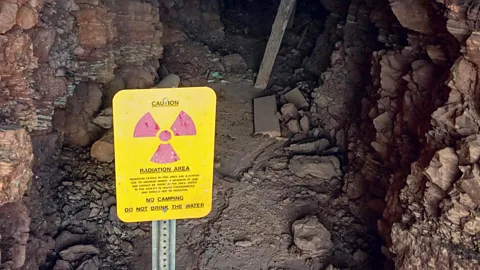 Andrew Walker
Andrew WalkerMost of us try to avoid radiation, but not Andrew Walker, who collects radioactive objects. The surprising part? These items can be found in antiques shops, parking lots and buildings everywhere.
It began with an online video. Andrew Walker had watched as a collector of radioactive objects showed off the items he had procured over the years, such as antiques containing uranium. Walker thought that looking for such pieces ‘in the wild’ might make an interesting and unusual hobby – so he bought himself a Geiger counter.
He quickly realised, as scientists will tell you, that radioactivity is everywhere. The first elevated reading he got was in the parking area at a Mexican fast-food restaurant in Idaho. “I noticed that when we pulled in there, my Geiger counter was going off,” he recalls. Something nearby was flinging out the tiny subatomic particles that make up radiation in slightly higher quantities than might be expected – and though he couldn’t figure out what it was, Walker was suddenly aware of this otherwise invisible activity.
After that, he began looking for other intriguing examples.
His pursuit of radioactive objects is still a hobby. By day, Walker is a cinema projectionist and a film-maker, not a scientist. But he enjoys sharing some of his finds on Twitter and Instagram, where he can discuss them with others who are similarly curious.
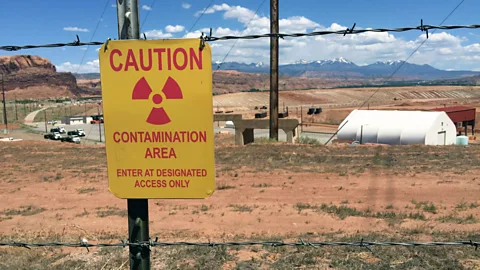 Andrew Walker
Andrew WalkerRadioactivity is something we live with constantly – it’s always there in relatively small amounts. Around the world, naturally occurring, higher-than-average levels of radioactivity are found in various types of beaches and soils, among other places. Meanwhile, most concrete is radioactive, though levels obviously vary. In the US, it is possible to get your home tested for radon gas – which is produced slowly over time by radioactive construction materials. Even the human body is slightly radioactive because we contain elements like potassium-40, which decay.
Walker lives in Bozeman, Montana. He later discovered a curious historical fact: slag containing small amounts of uranium and radium was used in the past for concrete used in construction in his neighbouring state of Idaho. He wonders whether this led to his readings outside the Mexican restaurant.
Walker likes to plan trips to local areas where he thinks he might find interesting material. If he does, he then documents his discoveries. There are plenty of old uranium mines (and now deserted uranium mining towns) in the US and Walker has visited some of these on his travels.
He also began frequenting antique malls. “At every antique shop I have ever gone to so far, I have always been able to find something radioactive,” he says.
These items include “Vaseline” glassware, which contains uranium and is a striking yellow-green in colour. But he’s also found orange-red plates and bowls that were coloured with a uranium-based dye and which often produce even stronger readings. The US government guidelines advise against using such crockery for food or drink, though the health risk of simply owning these items is negligible.
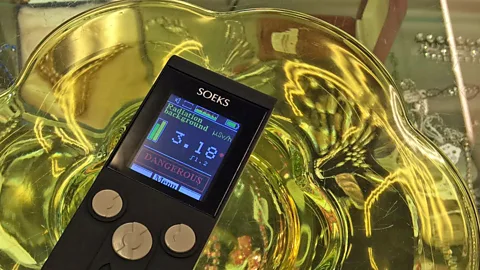 Andrew Walker
Andrew WalkerThen there are watch and clock faces with glow-in-the-dark paint that contains radium. Such objects are relatively safe as long as they are not taken apart, but the women who made them in factories would often hold their paint brushes using their lips. This caused them to ingest small amounts of the radium paint. As a result, many developed serious illnesses including bone cancer in their jaws.
This is why Walker tries not to put himself at any unnecessary risk.
What is radiation?
Radiation is essentially energy. The radiation detected by Geiger counters concerns energy released by decaying atoms – atoms that are constantly expelling a barrage of tiny particles. Some of this radiation can dislodge electrons from other atoms to create charged particles – this is known as ‘ionising radiation’. Three key forms of ionising radiation, from largest to smallest, are:
Alpha – A bundle of two protons and two neutrons
Beta – An electron, or positron, which is like a positively charged electron
Gamma – Tiny photons, which at different wavelengths also make up visible light
Radioactive elements that decay producing these forms of radiation include uranium and radium. Alpha particles can be stopped with a sheet of paper, or the outer layer of human skin. But gamma rays can penetrate much further and are often only blocked by very dense materials such as lead.
Still, his new hobby has intrigued friends and family. “They ask why am I going to these places and exploring this stuff,” he explains with a laugh. “It’s something I’m interested in; it’s just fascinating.”
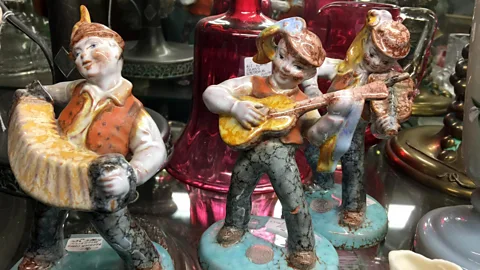 Andrew Walker
Andrew WalkerHe’s even found a few local landmarks, including public buildings like train stations, where the tiles produce slightly elevated levels of radioactivity – again, presumably a result of having been made with particular dyes or glazes.
Geiger counters are easy to make – so much so, in fact, that some hobbyists assemble their own and experiment with finding sources of radioactivity with which to test them. Walker himself bought one for $1,300 (£930), a RadEye meter that detects alpha, beta and gamma radiation (see box, “What is radiation?”).
Radiochemist Nick Evans at Nottingham Trent University points out that radioactivity can be measured in a variety of different ways. One approach is to observe the rate of nuclei decaying over time; the international unit used for this is the Becquerel. But people may be more familiar with measurements in Sieverts (or indeed Microsieverts or Millisieverts).
This is the effective dose of the radiation and the unit Walker uses. However, Evans says that the standard way of taking these readings is actually to hold the Geiger counter one metre away from the source so that objects’ radioactivity can be compared accurately.
High energy
The fascinating thing about Walker’s expeditions is the ease with which he has found so many examples. Evans says this is partly a legacy of industries that treated radioactivity as a potential marketing ploy in the decades following its discovery in the late 19th Century. It was quickly capitalised on as a potential selling point for weird and wonderful new products.
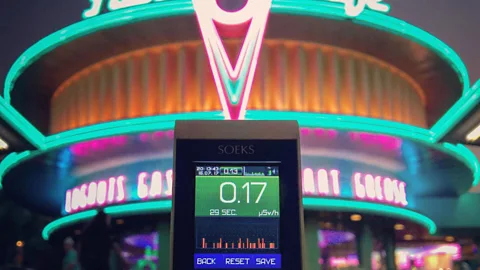 Andrew Walker
Andrew Walker“It was very, very different to anything else,” says Evans. “It was sort of mystical and people obviously wanted to try all sorts of things with it, play with it, if you like.”
Some of the things manufacturers came up with are mind-boggling today. Take radioactive suppositories, for example, a ‘treatment’ with no actual grounding in medical science. Surely there are safer ways to restore “your normal manly vigour”.
But that wasn’t the only health-related product seeking to help patients to a dose of decaying atoms. There was also radioactive toothpaste and even condoms.
“I’ve no idea what the thinking behind those was,” says Evans of the latter. “I have a tin of them – not that I use them, I hasten to add.”
 Getty Images
Getty ImagesThe notion that increased doses of radioactivity could somehow be good for you is still with us today. There is a spa in the Austrian Alps called Bad Gastein where people can visit the humid tunnels of a former gold mine and sweat away their ailments – while breathing radon gas.
Many scientists have long bemoaned the public’s instinctive distrust of anything to do with radiation. Anxiety associated with it is exaggerated, argue some. Indeed, dangers like pollution don’t spark the same sense of trepidation and yet pollution kills millions of people every year. One study found that, in stark contrast, only 190 people died between 1980 and 2013 as a direct result of overexposure.
Walker says that many fears increasingly seem “irrational” to him thanks to his explorations. On the other hand, of course, his treks and antique shop visits really just show off how ubiquitous radioactivity really is.
If you liked this story, sign up for the weekly bbc.com features newsletter, called “If You Only Read 6 Things This Week”. A handpicked selection of stories from BBC Future, Earth, Culture, Capital, and Travel, delivered to your inbox every Friday.
